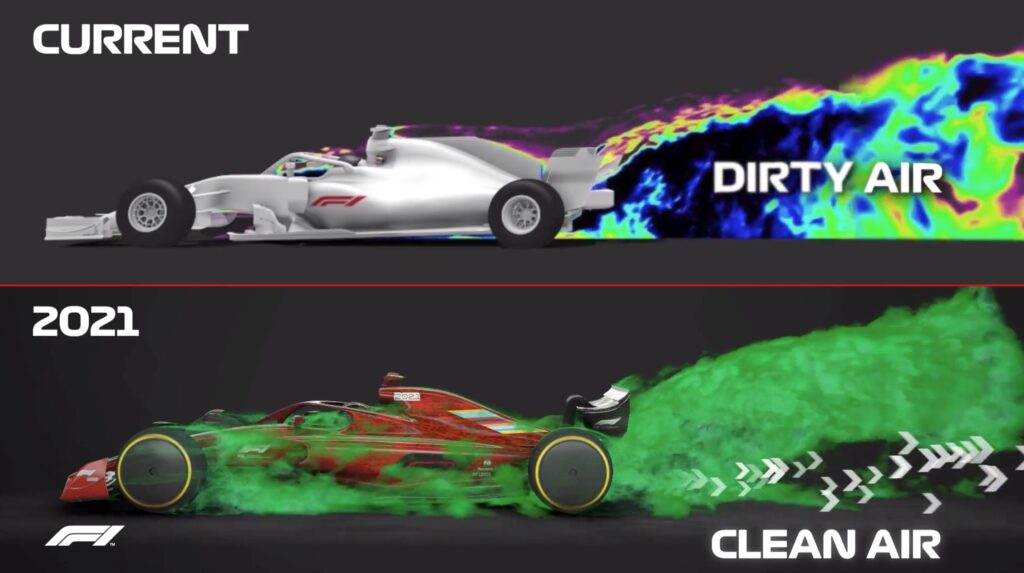F1 2022 car was unveiled yesterday in Silverstone. In this section, we look into all the exciting new features of the car and the tech behind it.
Close Following.
After a massive regulation change in 2014, 2022 sees a step into another era, in the aerodynamics department. The F1 2022 car is designed in such a way that it can follow more closely. The Clean air generated by the car’s now quite literally sticks them to the ground at immense speeds. But this also creates dirty air and Vortexes on the back of the car making it dirty for the next car.
The F1 2022 car, will have its design based on Close racing so the air is disturbed very less in providing clean air to the car following it making the race closer.

This new F1 2022 car, according to the data, increases the downforce of the following car by 95% compared to 35% in the current iteration following at 20 Mts and 10 Mts there is an increase of 46% according to FIA data shared with the teams. But this is only FIA Data, the likes of clever engineering will make the gains even higher.
Ground Effect is Coming Back in F1 2022 Car
Ground-effect underbody tunnels have not been permitted in Formula 1 since 1982, but the calls for their reintroduction have become rather loud in recent years. F1 has sought to reduce the current reliance on wings for downforce, which have been blamed for the “dirty air” that makes close-quarters racing difficult in modern racing, which made the idea of a return to ground effects more attractive to the rule-makers.
By creating a very pronounced entry at the front of the floor, the air moves through two Venturi tunnels. As the air flows under the car, it’s squeezed through the point closest to the ground, developing an extreme low-pressure area, creating a large amount of suction underneath. This means the floor is relied on more for downforce and reduces the wake produced by various bodywork components.

Unlike the old-school ground effects, the car won’t have sliding skirts and instead has a range of fins underneath to minimize any disturbance. To make sure each team uses the floor as it should, a standard tea tray will be developed to attach to the front of the floor. The tires will also change, as F1 moves to an 18-inch rim for 2022.
Same Power Unit
Many, many things are new on the 2022 car – but the power unit is not one of them, with Formula 1 set to retain the current 1.6-liter turbo-hybrid units. This is no bad thing, given that they’re already the most advanced and most efficient engines on the planet. There will, however, be some more standard components in the fuel system, as well as some additional sensors to allow the FIA to better monitor the power units. So until 2025 then…

Synthetic Fuels
F1 has said that it will be carbon neutral in 2030 and it’s not electrifying the cars. This means the race to produce synthetic fuels will be in full force. All the racing series across the world are potential customers. It is the main reason Porsche jumped on this so it could continue selling the specialist vehicles like 911 GT3’s. Audi did tiny research in 2015 but stopped in 2018.

Grojean and Anthoine Hubert
F1 remains a dangerous sport, so the goal to improve safety is unrelenting. The F1 2022 car will be able to absorb 15% more energy in the front and rear impact tests. The Grojean incident means, that the engine must separate from the chassis without exposing a fuel tank on impact. The Squeeze test number is also increased considerably, and a 48% increase in absorption in the homologation tests is required to certify the strength
Meanwhile, learnings from the FIA’s investigation into Formula 2 racer Anthoine Hubert’s fatal accident at Spa in 2019 were also incorporated, principally a longer nose section to help dissipate energy in a crash, together with stronger chassis sides to resist T-bone incidents. It’s also true that those safety improvements, as well as the heavier and more robust tyres, have seen a weight increase, with the minimum car weight has risen by around 5% from 752kg currently to 790kg.

F1’s Motorsports team are confident that they’ve come up with a set of regulations that can achieve their objective of closer racing, while not being so prescriptive that they prevent creativity.




